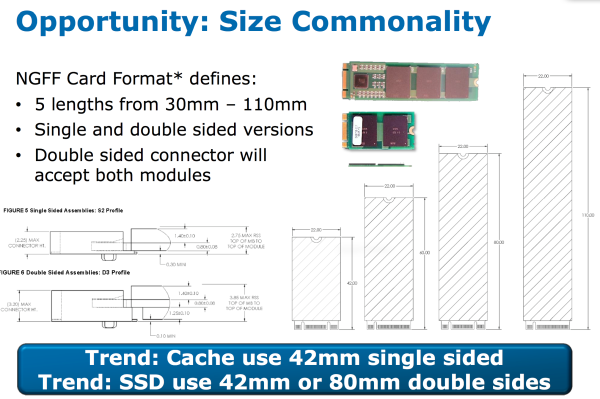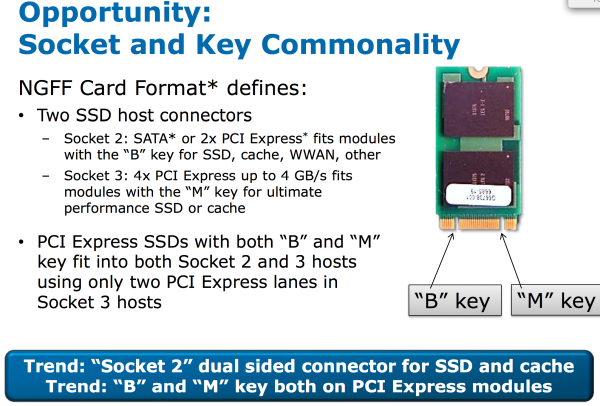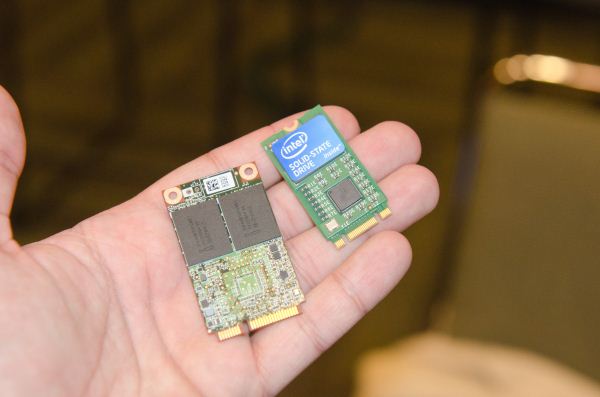NGFF SSDs: Putting an End to Proprietary Ultrabook SSD Form Factors
by Anand Lal Shimpi on September 13, 2012 2:32 PM ESTWe've seen a bunch of custom SSD form factors with the arrival of Ultrabooks as well as systems like the MacBook Air and Retina MacBook Pro. The need is simple: standard 7mm or 9.5mm SSDs are too big for some of these machines, and you don't actually need all of that volume to build a fast drive. mSATA cards work as a small form factor solution but they are only available in a single size. We need flexibility both on length (to allow for higher capacities) as well as on the interface side to enable higher performance. The NGFF specification gives us just that.
The spec allows for SATA, PCIe x2 or PCIe x4 interfaces. It also includes definitions for five different card lengths.
The proposed spec includes two connector definitions: Socket 2 and Socket 3. Socket 2 allows for SATA or PCIe x2 interface for SSDs, WWAN or other non-storage devices. Socket 3 is strictly for high-performance storage, offering up to 4GB/s of bandwidth in a tiny little package.
This is super exciting as far as I'm concerned. We've strayed too far from standardization and upgradability in the pursuit of ultimate mobility. Now all we need is a smaller form factor user replaceable memory standard.
Update: I just got some hands on shots with a few NGFF samples:
mSATA on the left, NGFF on the right



















41 Comments
View All Comments
macuser2134 - Friday, September 14, 2012 - link
Good question. When they debated and discussed the standard, will have been some kind of careful rationalization for their decision to keep SATA compatibility. I am guessing they just really want to give their new standard best chances for being adopted by the industry. All of today's successful SSD designs are SATA III. It is so much cheaper for the manufacturers to re-cycle a current SATA 3 design, just re-work it onto the new PCB form factor.As for the argument that mSATA is good enough. Well, unfortunately it really isn't. the only thing mSATA was ever suited for is small cache drives and small boot drives. It's simply not big enough to accomodate enough NAND chips.
Forgetting PCIe for now, and thinking only about SATA drives: the new standard is still far more suitable to notebook + SSD makers than mSATA. Because a) they can make much larger capacities which were not possible with mSATA, and/or 2) use the much cheaper lower density NAND chips with the sensible choice(s)/options for PCB area. Meanwhile, the overall size of your notebook or mobile device remains almost exactly the same.
Now about the PCIe lanes, and having 2 physical connectors: Well, these standards people probably realized they didn't know the answers to some very important questions:
Will the faster PCI 4x lanes connector ever be needed? By the time we have reached the 2GB/s limit, then PCIe 4.0 specification will be already released, and version 4.0 of PCI consortium are aiming again to double the bus speed over the previous PCI specification. So that speed increase (4GB/s) might equally be achieved by staying with the original SATA-compatible connector, rather than wheeling out the PCI-only connector. Nobody knows yet.
And if the PCI bus is made faster, then the problem is deffered. The question then becomes: will 8GB/Sec speeds be needed in 2015+... and again nobody currently knows or can predict that either. However by then the SSD manufacturers will have had plenty of time to stop making SATA 3 drives completely, and instead we will have a healthy market for the first-gen PCI 3.0 2x lane drives. At that time, when SATA finally dies, the notebook makers will all be making their new laptops with the 2nd kind of PCI-only slot. So then it doesn't really matter. Any remaining consumers still hanging on to 5-year old notebooks will still be able to buy 2Gigabyte/sec 2-lane SSDs for them. Just like you can buy very cheap Vertex 2's today. Its really the same thing as SATA 1 backwards compatibility.
Alexvrb - Saturday, September 15, 2012 - link
Deferring the problem? Until what day? Until Intel comes in and fixes the problem, and in doing so creates another proprietary connector? You're endorsing their lazy stopgap measure. 4 lanes is 4 lanes. It would be twice as fast today, and twice as fast when they implement PCIe 4.0, whenever that eventually happens. If they pushed Socket 3 only, we'd have a lot more machines with that instead of Socket 2, with the then-defunct SATA half and gimped bandwidth. By the time PCIe 4.0 comes around, I fully expect both mSATA and the SATA half of Socket 2 to be obsolete.We already have PCIe-based SSDs. Manufacturers seem to be capable of building them. If there was a real demand, they'd build tons of them, and costs would plummet. I'd prefer to see a healthy market of 4 lane devices, instead of ending up with a split market. So like I said, I think they would have been better off sticking with mSATA for the current generation less-expensive SATA III compatible interface, and then phasing it out entirely for a pure PCIe setup. Have you even looked at any mSATA drives recently? They've got 256GB M4 and XPG drives on Newegg. The prices aren't even all that bad, for that density.
Anyone that needed more speed, capacity, or the new form factor could then use a Socket 3 4-lane solution, which should supersede mSATA over time. Others could stick with mSATA if it suits their needs, for cache drives or even primary storage in some devices. Instead, now we have mSATA, and not one but two new sockets, one of which has... SATA and 2 lanes. The two lanes part is barely faster than SATA 3, why bother? Again, by the time PCIe 4.0 comes out, mSATA should be phased out anyway for this sort of application.
Imagine if (when PCIe was first introduced) there were two PCIe interfaces, and two incompatible connector types, one was pure PCIe. The other was half PCI, half PCIe (with half the lanes of the same size PCIe connector). On top of this, you can't connect older PCI cards. You can build cards that fit both slots, but they only use half the PCIe lanes if connected to a pure PCIe slot. It's not quite a perfect comparison, but it's just about as silly.
Pessimism - Friday, September 14, 2012 - link
Guaranteed Apple will still make some subtle tweak to theirs, an extra pin, a different voltage to keep their stranglehold over parts supply.web2dot0 - Friday, September 14, 2012 - link
Please refrain from conjecture and speculation until the facts are in. Just makes you look like a Apple Hater.The previous posters said, Apple needed proprietary specs because they needed SSD of non-standard dimensions and high capacity SSD drives.
If you don't like it, don't buy them. Let the market speak, not your mouth.
I thought we are all for the market? What happened to capitalism?
extide - Friday, September 14, 2012 - link
Yeah but they changed the pinout on their drive several times for no reason other than to have stranglehold over parts supply.Pessimism - Monday, September 17, 2012 - link
The previous posters are speculating as much as you claim I am. Somehow every other major manufacturer manages to make thin and light laptops using industry standard, MSATA parts. The argument that Apple NEEDS to use their own oddball, vendor locked size of part to manufacture a laptop is pretty weak. As the other poster below mentions, this is not the first time nor will it be the last that Apple modifies standard components to only work with their systems. Google "Apple hard drive firmware". Also, their OS disables TRIM on non-apple SSDs. Their OS used to cripple non apple optical drives.euler007 - Tuesday, January 29, 2013 - link
Man, Apple shareholders are really on edge.Casper42 - Monday, September 24, 2012 - link
I wonder if it would be possible or really feasible to use these new SSDs as a higher tier cache on Enterprise and possibly consumer RAID controllers.Small enough that they could bolt one on to the Controller and either access it as SATA or maybe through a PLX type chip on the card.
Intel has their Consumer side SSD as a cahe (Forgetting the name)
HP introduces Smart Cache on their Gen8 line of Smart Array controllers
3rd Parties like VeloBit's HyperCache can do this on almost any machine.
Makes sense that the RAID controller (in those environments where you need one anyway) would be an intelligent place to put something like this.
Or maybe not. If you have the RAID controller and NGFF separate, then anything mentioned above would still potentially work.
Eh, just a thought (that didn't involve Apple)
Casper42 - Monday, September 24, 2012 - link
PS: I would also love to see in a year or two, both a traditional 9.5mm SATA slot AND this NGFF in a standard sized notebook (obviously too bulky for UltraBooks) and just ditch the Optical drive already. Isn't USB 2.0 faster than most if not all BluRay drives let alone DVD?Would raise the cost of the machine what, $5?, to include a USB DVD drive instead of a built in.
Hell, Starbucks could even sell $30 USB DVD drives in store for people who forget theirs and absolutely have to have one in a hurry.
Valantar - Monday, May 20, 2013 - link
I know this post is really old, but I just came across it, and I'm not sure I'm very happy about what I see with the two incompatible(?) connectors. First of all, what is the problem with maintaining SATA compatibility on the type 3 connector? If anything, shouldn't this be possible to do on the controller/hardware side (mSATA ports supports both SATA and PCIe, no?)? Secondly, why have two different connectors at all? I understand the size/thickness argument, but seriously, that should be possible to overcome in basically any device with some good design/engieneering (considering the amount of air found inside most devices outside of smartphones, this should be solveable). All I see this resulting in is manufacturers going the cheap route with their laptops/tablets and using the "cache only" connector, rather than the faster type 3 connector and thus screwing consumers out of the option of upgrading to a higher capacity/performance SSD. At least a spec like this should make it mandatory for manufacturers to state both connector type and max card length in device specifications. Also, why make a spec for a 30mm card without ever mentioning it again, and specifically leaving it out of the proposed usage examples? The suggestion that SSDs use 42 or 80mm cards also leads me to think that 110mm cards (and thus the highest possible capacities) will both be incompatible with most devices and very rare (produced in small quantities), leading to exorbitant pricing both for devices supporting these and the SSDs themselves. Again, a bad idea. However, if the type 2 connector could see use as a replacement for the horribly slow eMMC storage used on many tablets today, that would be a worthwhile usage scenario, albeit the only one I see where the type 3 might not be possible.